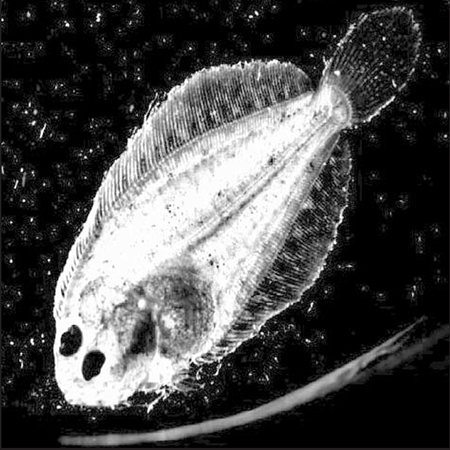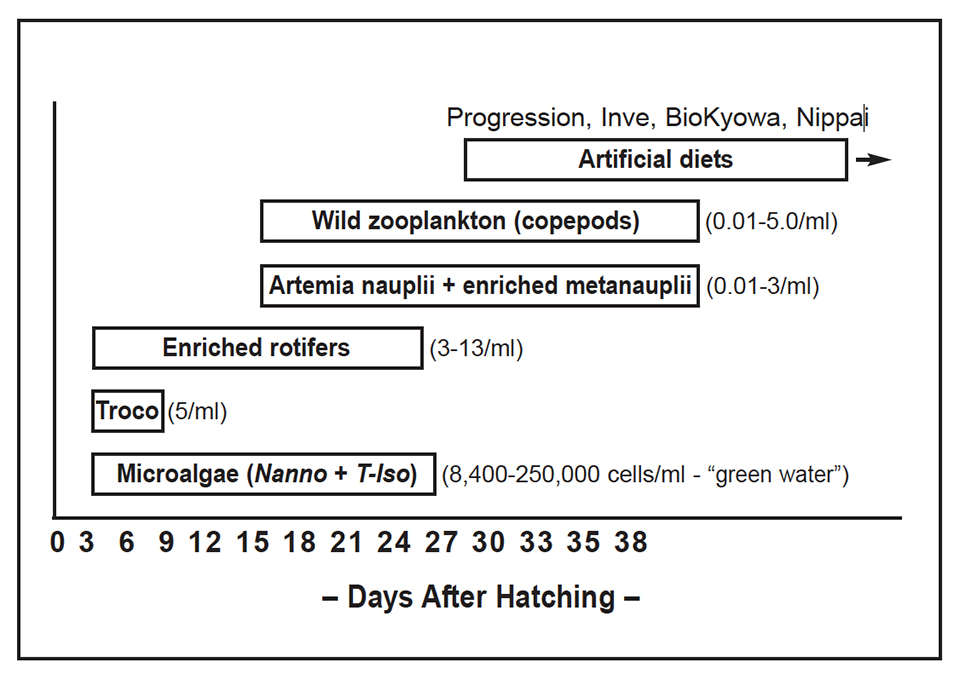System for Paralichthys lethostigma developed in the southeastern U.S.
 The feeding schedule is a crucial component of the husbandry protocol for larval fish, especially during first feeding and metamorphosis, when the fish postlarvae are weaned from live feeds onto artificial feeds.
The feeding schedule is a crucial component of the husbandry protocol for larval fish, especially during first feeding and metamorphosis, when the fish postlarvae are weaned from live feeds onto artificial feeds.
Following the pioneering work conducted in the 1970s in Texas by Connie Arnold, researchers working in Florida (Harbor Branch Oceanographic Institution, HBOI), South Carolina (Department of Natural Resources) and North Carolina (North Carolina State University and University of North Carolina) have developed protocols for spawning, larval rearing and fingerling production of Southern flounder (Paralichthys lethostigma).
The work, conducted simultaneously and independently by Ted Smith, Wally Jenkins, Jesse Chappel, Wade Watanabe, Dave Berlinsky, Craig Sullivan, Harry Daniels, Dan Benetti and Kevan Main, has been partially funded by the Sea Grant College Program, USDA and the Disney Wildlife Conservation Fund.
Southern flounder broodstock were collected from the wild, acclimated to captivity, and stocked in maturation tanks at a sex ratio of 2:1 (male: female). In Florida, spermatogenesis has been successfully accomplished with 100 percent of the males, using temperature manipulation during a three-month acclimation period.
Vitellogenesis was nearly completed when females were caught, and final ovulation has been accomplished using hormone implants (GnRH) and human chorionic gonadotropin (HCG) provided by Yoni Zohar from the University of Maryland’s Center of Marine Biotechnology. Several hundred thousand fertilized eggs were obtained from both tank and strip spawnings.
Although fish began synchronized spawning only after being injected and implanted with hormones, tank spawnings occurred almost daily for a period of six weeks – when the water temperature in the tank was purposely raised from the threshold 17 to 22 degrees-C and the fish ceased spawning. At 26 degrees-C, fertilized eggs of Southern flounder hatched within 24 to 28 hours, with an estimated hatching rate of fertilized eggs of 50 percent. Although hormones are generally used to successfully induce flounder to spawn, natural spawnings have been recently obtained by researchers in North Carolina and South Carolina.

The feeding protocol for larval husbandry of Southern flounder includes overlapping live and inert feeds (Fig. 1). Microalgae (T-Iso, C-Iso, Isochrysis spp and/or Nannochloropsis spp), trocophore larvae of hard clams (Mercenaria mercenaria), rotifers (Brachionus plicatilis), as well as artemia nauplii and enriched meta-nauplii have been used for feeding the larvae through metamorphosis.
It is suggested that a combination of commercial feeds including Progression, Lansy/NGR, Biokyowa and Nippai marine fish starter dry feeds be used for weaning and during the fingerling stage.
Weaning onto artificial diets is conducted between the third and fifth weeks. After 42 days, metamorphosis is completed. Daily water exchange rate is progressively increased from 10 percent to 100 percent between the first and fourth week post hatching. Standard larval husbandry protocol also includes daily cleaning by siphoning the bottom of the tanks and skimming the water surface. The results obtained with raising Southern flounder varied among the various trials. At HBOI, average survival rate from hatching to fully metamorphosed postlarvae has been 16.25 percent, ranging from 40.48 percent to 5.19 percent.
Postlarval flounder are stocked at 1 per liter in 800- liter nursery tanks, where they are routinely graded and fed pellets to satiation 8 times per day. Survival rate during the nursery stage averages 13 percent.
Curiously, approximately 10 percent of the fingerlings exhibit coloration (pigmentation) abnormalities such as hypomelanosis or pseudoalbinism, and a small percentage of the juveniles shows reverse asymmetry or no ocular migration at all (in flatfish, one eye migrates to the other side during normal larval development, so that both eyes are on the same side of the animal). Grow-out trials with juvenile flounder are currently underway in a 100 ton (20×5×0.5 meters) raceway, using freshwater recirculating system in a greenhouse at HBOI’s Aquaculture Development Park in Florida.
The evidence suggests that southern flounder is an excellent candidate for intensive aquaculture in tanks and raceways using recirculating systems. The technological feasibility of the operation has been proven and the researchers will continue to collaborate to demonstrate the economical feasibility of southern flounder aquaculture within the next 2 years.
(Editor’s Note: This article was originally published in the February 2000 print edition of the Global Aquaculture Advocate.)
Now that you've finished reading the article ...
… we hope you’ll consider supporting our mission to document the evolution of the global aquaculture industry and share our vast network of contributors’ expansive knowledge every week.
By becoming a Global Seafood Alliance member, you’re ensuring that all of the pre-competitive work we do through member benefits, resources and events can continue. Individual membership costs just $50 a year. GSA individual and corporate members receive complimentary access to a series of GOAL virtual events beginning in April. Join now.
Not a GSA member? Join us.
Author
-

Daniel D. Benetti, Ph.D.
University of Miami
Rosenstiel School of Marine
and Atmospheric Science
Division of Marine Affairs and Policy
4600 Rickenbacker Causeway
Miami FL 33149
Tagged With
Related Posts

Responsibility
Southern flounder culture at Texas Parks and Wildlife Department
The Texas Parks and Wildlife Department’s southern flounder stock enhancement has stocked more than 400,000 fingerlings into Texas bays and estuaries.

Health & Welfare
Dietary organic acids improve gut health, disease resistance in olive flounder
A study evaluated the effects of two organic acid blends on performance, gut health and disease resistance in olive flounder. The dietary organic acids were effective in lowering total gut bacterial counts, gut Vibrio counts and in conferring resistance against Edwardsiella tarda.

Health & Welfare
Advances in fish hatchery management
Advances in fish hatchery management – particularly in the areas of brood management and induced spawning – have helped establish aquaculture for multiple species.

Intelligence
Bahamas venture focuses on grouper, other high-value marine fish
A new venture under development in the Bahamas will capitalize on Tropic Seafood’s established logistics and infrastructure to diversify its operations from processing and selling wild fisheries products to include the culture of grouper and other marine fish.

